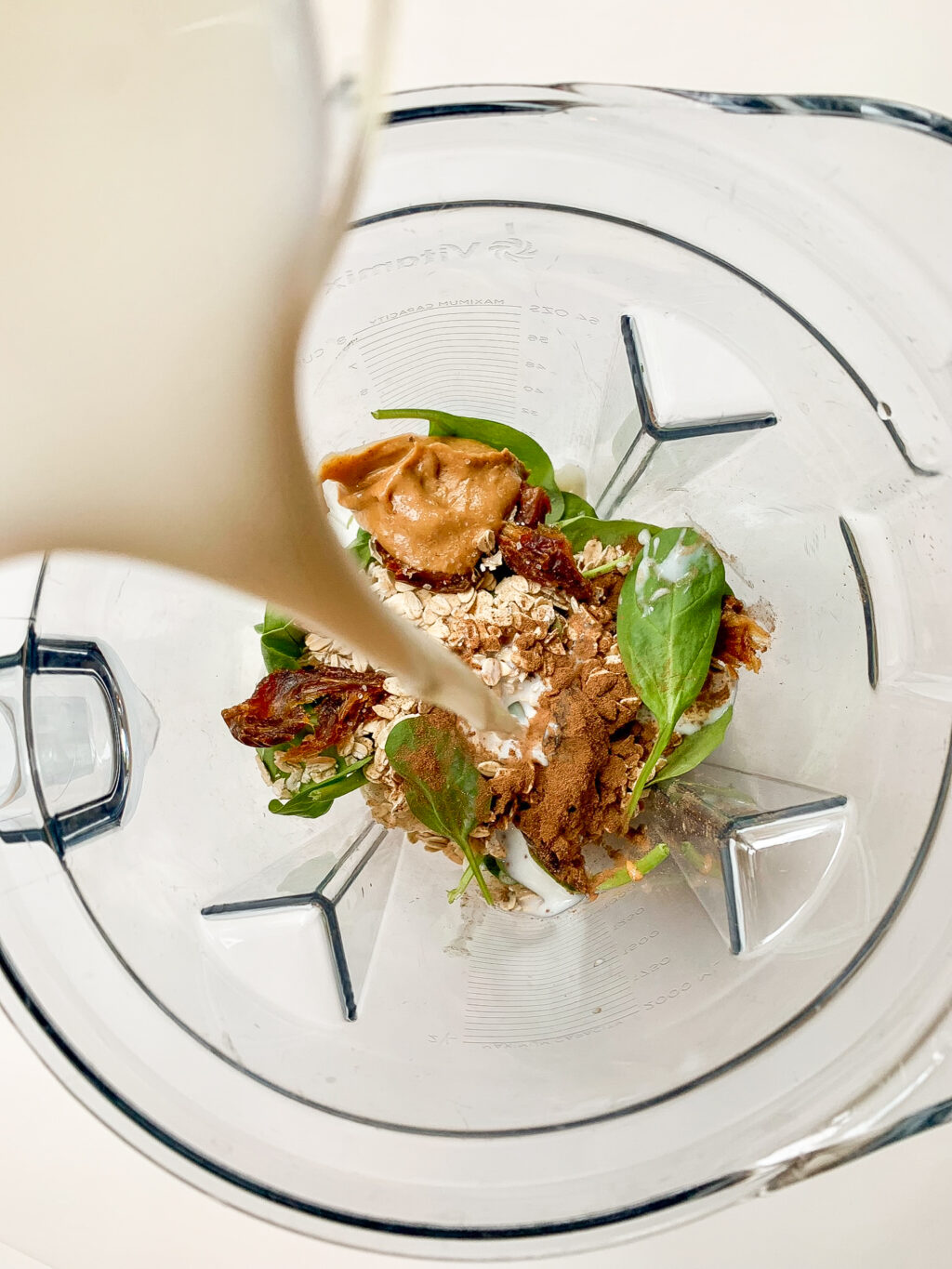As a dietitian and mom of three, my hope for the new year is to…
As a parent, making sure that your kids receive the proper nutrients (and enough of them!) from the foods that you serve is likely top of mind. With the new year upon us, this may be even more at the forefront of your mind, along with some other healthy goals or intentions for 2024. At this same time, if you’re anything like me, you may be feeling overwhelmed with the task of feeding your family. If you are the head chef in your house, constantly creating nutritious, cost-effective, well-accepted meals can feel like a lot. As a dietitian and mom of 3, I’m here to offer empathy, help you breathe a sigh of relief, and also offer some sanity-saving EASY nutrition hacks to help you along the way.
While deficiencies are relatively uncommon in North America, some nutrients like iron, calcium, omega-3 fats, protein and dietary fibre often raise concerns among parents, especially when their kids are more discerning with their food choices (aka… picky eating phases).
I know firsthand the worry that comes with seeing nutritious foods left untouched on my kiddos’ plates. But instead of focusing on all the things your kids aren’t eating, I want to encourage you to think about all of the fantastic foods they are consuming –not throughout a meal or even a day, but throughout a week.
As parents, it’s so easy for us to go into mealtime with an agenda for both what our children should eat and how much they should eat. What is this based on? Good question. Likely an arbitrary amount of food that somehow feels right to us and may stem from our childhood, how much other children (their peers or siblings) are eating, or even diet culture. The truth is, a child’s eating pattern (and appetite) can be unpredictable and quite simply, all over the map. It can ebb and flow and change from meal to meal, day to day and week to week. This is normal and ok. We also often overestimate how much our child needs in terms of nutrition too.
Deep breaths! Let’s take a step back and view our child’s nutritional intake from a broader perspective. Nine times out of ten, kids will meet their nutritional requirements over the week, even if some days or meals seem less balanced. In saying this, one very important job that we have as parents is to provide a variety of foods and nutrients at meals and snacks everyday. With that in mind, I want to share my top five easy ways to boost the nutrient density of your family’s meals. Don’t worry – these aren’t
1. Sprinkle in some nutritional yeast
If you haven’t tried nutritional yeast yet, it is a fantastic plant-based option to add a savory, nutty flavor to your favorite dishes! What makes it unique is that it contains all the essential amino acids, making it a complete protein similar to animal-based protein. Moreover, it is an excellent source of B vitamins crucial for energy metabolism, brain development, healthy red blood cells, and DNA synthesis. Who knew “deactivated yeast” could be so nutritious?! Here’s how to incorporate it into your meals:
- Mix into spaghetti or pasta sauce to add nutrition and savory flavor
- Mix into prepared boxed macaroni and cheese to bump up the nutritional content
- Sprinkle into cheese and chicken quesadillas
- Stir into cooked rice or mashed potatoes
- Sprinkle on bagged salads for a cheesy zip
- Combine with ground almonds or cashews with salt to make a nutritionally dense plant-based “parmesan” topping
 2. Crack open a can of lentils
2. Crack open a can of lentils
The lentil – a tiny yet mighty legume—may be small in size but packs a nutritional punch. Loaded with protein and iron, lentils are an excellent meat alternative that can add savory flavor and pleasing texture to a variety of family meals! They’re also a rich source of dietary fibre, vital for fostering a healthy digestive system, supporting immune function, and enhancing meal satisfaction by adding bulk! Not convinced your kids will like them? Not to worry! You can add lentils without making them the star of the show. In fact, allowing your kiddo to help you spoon some lentils into a recipe will improve the chances that they will try the end result. Another option is to offer a small container of lentils on the side of their meal to allow them the choice of how much they want to sprinkle in (or if they want to wait till next time to try them!). Here are some ideas on how to introduce lentils into your kids’ meals:
- Mix into tomato sauce served over pasta, or substitute half of the ground beef in the sauce with drained and rinsed canned lentils
- Add into canned soups during the last few minutes of cooking. This helps make the soup heartier and more satisfying
- Toss into salads for extra protein
- Use as a ground meat substitute in tacos or meatballs (see meal plan below)
- Add to flavorful curry dishes
- Blend into a delicious high-protein homemade muffin or granola bar recipe (see meal plan below)
3. Bring on the bone broth
While bone broth is touted as a “miracle” food in the wellness industry (insert dietitian eye roll here), it does have many redeeming qualities that I am a fan of. Bone broth is a flavorful liquid that develops by simmering chicken, turkey, beef, or pork bones in a mixture of water, salt, vegetables, herbs, and spices for up to a full day. The slow simmering process aids in extracting nutrients such as collagen, vitamins, and minerals. These nutrients are important building blocks for the body’s tissues, including hair, skin, nails, muscles, and joints. The electrolytes in bone broth can also help with your child’s hydration as well (especially during times of healing from a cold or illness)! If making your own bone broth feels a bit too ambitious, you can find pre-made bone broth in the freezer section of health food stores and some grocery stores. Here’s how you can incorporate bone broth into your kids’ meals:
- Cook macaroni in bone broth, and add bone broth to mix the cheese sauce packet for more nutrition
- Cook rice or pasta in bone broth for added nutrition and flavor
- Replace some of the milk or water added to mashed potatoes with bone broth for a subtle savory flavor and nutrition
- Use in casseroles or one-pot dishes for added flavor
- Add to homemade pasta sauces
- Make a ramen noodle bowl with sliced veggies, shredded chicken and a boiled egg
- Use when making homemade soups or stews (see meal plan below)
4. Mix in chia seeds and hemp hearts
Having chia seeds and hemp hearts in your kitchen is a simple trick to amp up the nutritional goodness in your kids’ meals and snacks. Be sure to store these seeds in an airtight container in a cool, dark place to help them last longer. These seeds have lots of omega-3-rich oils which can go rancid if not stored properly. Chia seeds are loaded with antioxidants, fibre, and essential nutrients like calcium and magnesium. And hemp hearts bring fibre along with essential nutrients like iron, zinc and vitamin E to the table. Here are some simple ways you can include them in your menu:
- Make chia pudding for a snack or breakfast
- Add into smoothies
- Sprinkle on top of granola and yogurt parfaits
- Sprinkle into cold cereal or oatmeal
- Mix into homemade energy bites (see meal plan below)
- Make chia seed jam for toast
- Add hemp or chia seeds to pancakes, waffles, or muffin batter
- Sprinkle hemp hearts on salads
- Add hemp to a peanut butter and jam sandwich
- Sprinkle hemp hearts into pasta dishes
- Add into a breakfast cookie recipe (see meal plan below)
- Add into a storebought trail mix to bump up the nutrient content
5. Blend or crumble tofu
Tofu, also known as bean curd, is a versatile plant-based protein that can be prepared in various ways, taking on the flavors of the dishes it’s used in! What’s even better? Whether it’s soft or firm, it’s a nutritional powerhouse, delivering a complete source of protein, calcium, iron, zinc, selenium, and magnesium. These nutrients are MVPs in the body for robust immune function, strong bones, and healthy circulation. Unlike meat, tofu doesn’t require cooking to be safe to eat, and it has a longer shelf life in the fridge. In my opinion, this makes it the perfect nutritional hack to keep on hand for whipping up quick and nutritious meals for my family! Here are some simple ideas of how to use tofu in your kids’ meals:
- Make a tofu scramble
- Mash and use as a tofu salad sandwich
- Blend into smoothies or smoothie bowls
- Blend into a sauce
- Make tofu nuggets (see meal plan below)
- Add to tomato sauce as a meat substitute
- Use as a quick protein in a veggie stir-fry
- Blend silken tofu into a pancake or waffle batter for a protein boost, adding moisture without affecting the flavor

Other quick and easy nutrient-boosting food hacks
- Leafy greens– Dark leafy greens contain a wide array of essential nutrients for your child’s growth and development including vitamins A, C, K, iron, potassium, fibre, and antioxidants. Try adding a handful into smoothies, soups, stews, finely chopped into omelets or quesadillas. You can also blend into a pesto sauce, add into wraps or rollups paired with turkey cheese and hummus, make kale chips, blend into muffins or pancakes, or blend into a popsicle fruit mixture for added nutrition.
- Pitted dates- Contribute a natural source of sweetness along with dietary fibre, B vitamins, magnesium, potassium, and antioxidants to protect cells from free radical damage. They are great chopped up and added to granola, trail mix, cookies, and even salads! They blend well into no-bake energy balls and bars adding delicious texture and sweetness.
- Skim milk powder- a shelf-stable form of milk that can be incorporated into a variety of meals and snacks including smoothies, oatmeal, baked goods, soups, sauces, mashed potatoes, as well as homemade granola bars or energy balls. Skim milk powder is an easy way to add more protein, calcium, vitamin A, vitamin D, and B vitamins into family meals.
- Frozen fruit- Frozen fruit is picked at peak ripeness and flash frozen, keeping it shelf stable for much longer. It is an easy way to boost your child’s meal or snack with dietary fibre, immune system-supportive antioxidants, vitamin C, vitamin A, and potassium. Mix frozen fruit into smoothies, baked goods, yogurt parfaits, fruit popsicles and oatmeal as some quick and easy options.
- Canned coconut milk- Coconut milk is a great way to add more energy and healthy dietary fat to your child’s meal. It also contains vitamin E which acts as an antioxidant and supports skin health. Use coconut milk to make flavorful sauces and soups, or try mixing into smoothies, baked goods, and oatmeal.
- Nut and seed butters- packed with healthy fats, fibre, protein and essential nutrients like vitamin E, zinc, and iron, nut and seed butters are one of the most versatile ways to bump the nutritional goodness of your kids’ meals. Spread them on toast and tortillas, drizzle into oatmeal or ice-cream, blend into smoothies, soups or sauces, or mix into baked goods, or non-bake energy bites.
Steal this 3-day meal plan using nutrient-boosting hacks!
|
MEALS |
DAY ONE |
DAY TWO |
DAY THREE |
|
Breakfast |
Banana date smoothie |
Whole grain toast or English muffin with poached eggs and fruit |
Carrot Apple Muffins |
|
Snack |
Snap peas and hummus
|
Frozen berry yogurt parfait |
Sliced apple with cheese + crackers |
|
Lunch |
Toddler-friendly tofu nuggets with cucumber and carrots on the side
|
Turkey and lentil meatballs served over pasta and tomato sauce |
Tuna salad made with mashed avocado and chopped celery on whole-grain toast or wrap |
|
Snack |
|
||
|
Dinner |
Big batch easy cheesy mac and cheese with frozen peas
|
15-minute coconut Thai chicken noodle soup (replace chicken broth with bone broth) |
with rice and sauteed mixed veggies |
Meet Sarah
 Sarah Remmer, is a registered dietitian (since 2006) mom of 3 and the proud founder and President of The Centre for Family Nutrition, a Calgary-based nutrition counseling practice that specializes in prenatal, infant and child nutrition, that specializes in prenatal, infant and child nutrition.
Sarah Remmer, is a registered dietitian (since 2006) mom of 3 and the proud founder and President of The Centre for Family Nutrition, a Calgary-based nutrition counseling practice that specializes in prenatal, infant and child nutrition, that specializes in prenatal, infant and child nutrition.


 2. Crack open a can of lentils
2. Crack open a can of lentils 


